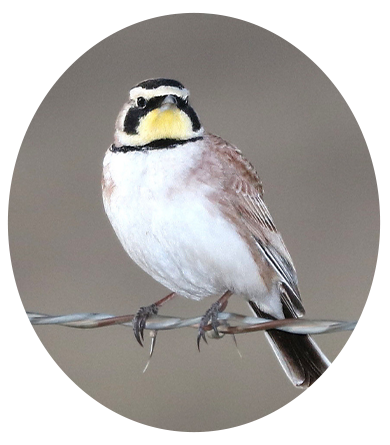

SCIENTIFIC NAME: Eremophila alpestris


The Horned Lark is a small, long-bodied songbird with a short thin bill, short neck and a rounded head. It is found across the northern hemisphere.

Adults measure about 6.3 - 7.9 inches in length, with a wingspan of 11.8 - 13.4 inches and weight of 28 - 48 grams.
Males are sandy to rusty brown above, with a black chest band, a curving black mask, and head stripes that extend to the back of the head (sometimes raised into tiny “horns”). The face and throat are either yellow or white. The underparts are white. Females have similar head and breast patterns but are less crisply defined.
Juveniles have heavily spotted black-and-white head and upper parts. Throat and lower neck sides are white, whereas the breast band is mottled. They resemble adult after the autumn molt.

CALL: Flight calls are high-pitched, mournful, thin “siit-di-dit”. The alarm call is a high “pseeeee”. Varied other calls include high, sweet “t-sleep”, a buzzy “tzzzip” and a rolled “trri-it”.
SONG: A short and includes sweet, tinkling phrases “tu-a-li, tiali-ti” or similar. It is usually given by a bird perched on rock or in flight. The song flight is often uttered at great height and while hovering, a typical lark behavior.

Feeds on a variety of invertebrates during summer, such as grasshoppers, beetles, flies and lepidopteran larvae.
During winter, it feeds mostly on small grass seeds. Like many other birds, it also ingests small stones to facilitate the digestion of these seeds.

Found in open country with very short or no vegetation, including bare agricultural fields. They breed in short grassland, short-stature sage shrubland, desert, and even alpine and arctic tundra.

Breeds across much of North America from the high Arctic south to the Isthmus of Tehuantepec, northernmost Europe and Asia and in the mountains of southeast Europe. There is also an isolated population on a plateau in Colombia.
It is mainly resident in the south of its range, but northern populations of this species are migratory, moving further south in winter.

The female builds a nest in an excavated cavity or natural depression on the ground. It is a basket woven with plant materials and the inner part is lined with softer materials and feathers. Other materials such as stones, bark or animal dung are placed around the nest that is protected by some vegetation from wind and sun.
She lays 2 - 5 pale gray to greenish eggs with fine brown markings. She incubates alone during 11 - 12 days.

SOURCES:
https://www.allaboutbirds.org
http://www.oiseaux-birds.com
https://en.wikipedia.org